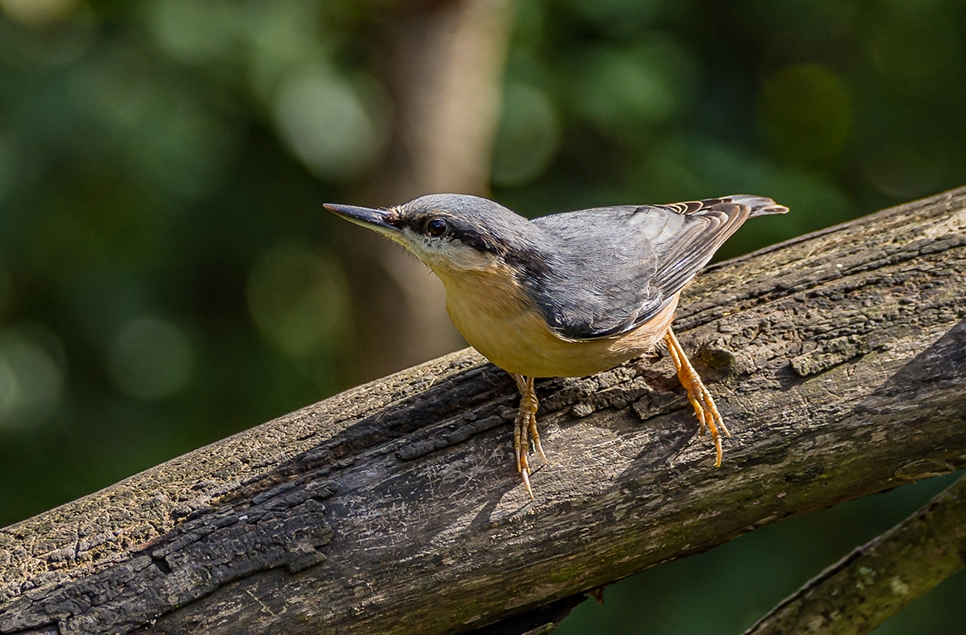Nesting nuthatch

For many of our visitors who enjoy a trip down to Hawthorn Wood Hide, the European nuthatch, with its pointed beak, bold black eye stripe and rufous flanks hopping effortlessly headfirst down the trunks of trees is a much-loved sight.
With its agile claws making light work of the tree bark terrain, even enabling it to hang upside down from cage feeders and overhanging branches; the nimble nuthatch continues to amaze onlookers as it sneaks in to snaffle a peanut or two for its stash. With spring underway, our resident Hawthorn Wood nuthatch pair have been very busy over the last couple weeks, flying into the hide together, stashing away nuts and seeds and (excitingly) starting to show signs of nesting!
To see more from our nuthatches on your next trip down to Hawthorn Wood Hide, check out our top things to look out for in our nuthatches below.
Top tips for nuthatch spotting:
- What they eat - As their name might suggest, nuthatches have a particular fancy for nuts and seeds, which they rely on as a food source during the autumn and winter months. At Hawthorn Wood Hide, our resident nuthatch pair have quite a taste for peanuts, regularly sweeping in to peck at the feeders and steal peanuts from the bird table. For a good chance of seeing them, keep your eyes on the peanuts in particular- our reserve team top up the feeding station every morning, so there are always plenty of peanuts to go around!
- Who’s who - If you’re lucky enough to catch a glimpse of our nuthatch pair dining out in the feeding station together (would that be a bird table for two?), see if you can spot the subtle differences between male and female birds. While different nuthatch sexes are almost identical, the male has slightly more rufous/browny-red feathers towards and underneath their tail, where the female’s coloration here will be more muted in comparison.
- Where do they come from - As for where to look, the nuthatch pair at Hawthorn Wood tend to fly in from stage right, swooping in from the woodland to the right of the hide. If you are up for a bird spotting challenge, wait until you see a nuthatch fly out and walk outside to the handrail at the right of our hide to see them stash their peanut cache in the surrounding decaying stumps and deadwood. This requires speed, stealth and excellent timing - nuthatches don’t wait around!
- What's that noise - Lastly, it's not all about what you can see. Sometimes half of birding is in what you can hear too. Sitting in Hawthorn Wood Hide you can regularly hear the repetitive ‘dwit-dwit-dwit’ call of the nuthatch as they bustle about stashing nuts and looking for invertebrates. At this time of the year, you can also hear the males singing to advertise their nesting site to their partner. Watch and listen to the video below to familiarise yourselves with one of their songs - personally, I think it sounds like they are cracking up over a really good joke.
What can we expect from our nuthatch pair in the coming weeks?
As cavity-nesters, our pair will already be preparing their chosen nesting site, usually a natural cavity, old woodpecker nest, or existing nest box for the breeding season ahead. Working together but with distinctive roles to prepare the nest, the male will gather materials, usually flakes of bark from the likes of larch or birch trees and pass them to the female, who will be responsible for using them to line the base of the cavity to construct a suitable nest. Excitingly, one of our nuthatches has already been seen carrying bark in their beaks!
If the cavity entrance is a bit too big for their liking, nuthatches are known to mould mud around the entrance to reduce its size as an anti-predator defence. The process of nest construction takes 2 to 4 weeks and then from mid April through to the start of May, nuthatches will lay up to approximately 8 eggs. These will be exclusively incubated by the female, with the male retrieving food for both female and any hatchlings that follow.
With a bit of luck, who knows, Hawthorn Wood Hide could be getting visited by nut-hatchlings later this year, so watch this space!
Blog written by reserve warden Kate Ferguson
Ready to visit?
If you've been inspired to explore Washington Wetland Centre, find out more and plan your visit online.
Plan your visit


